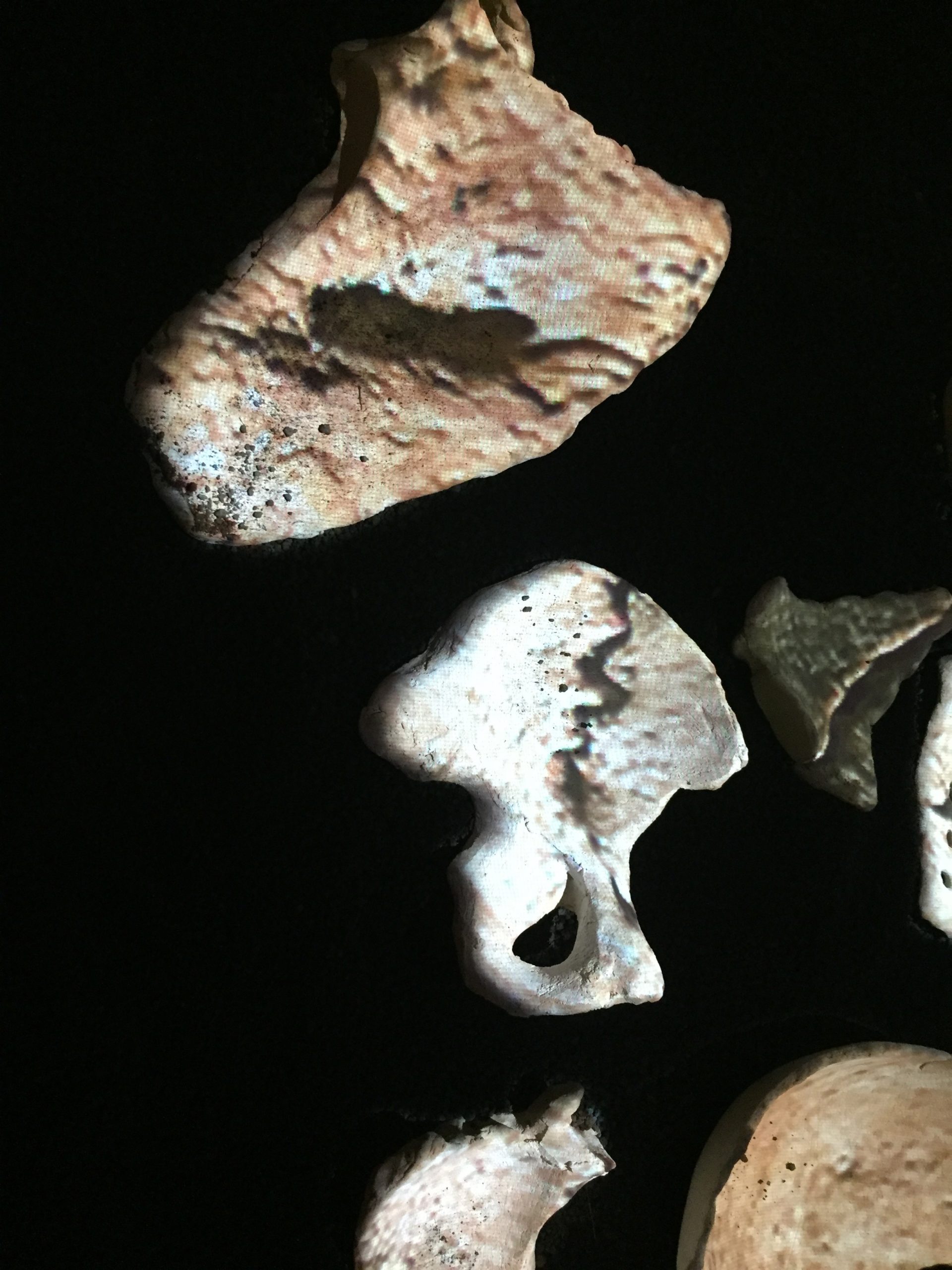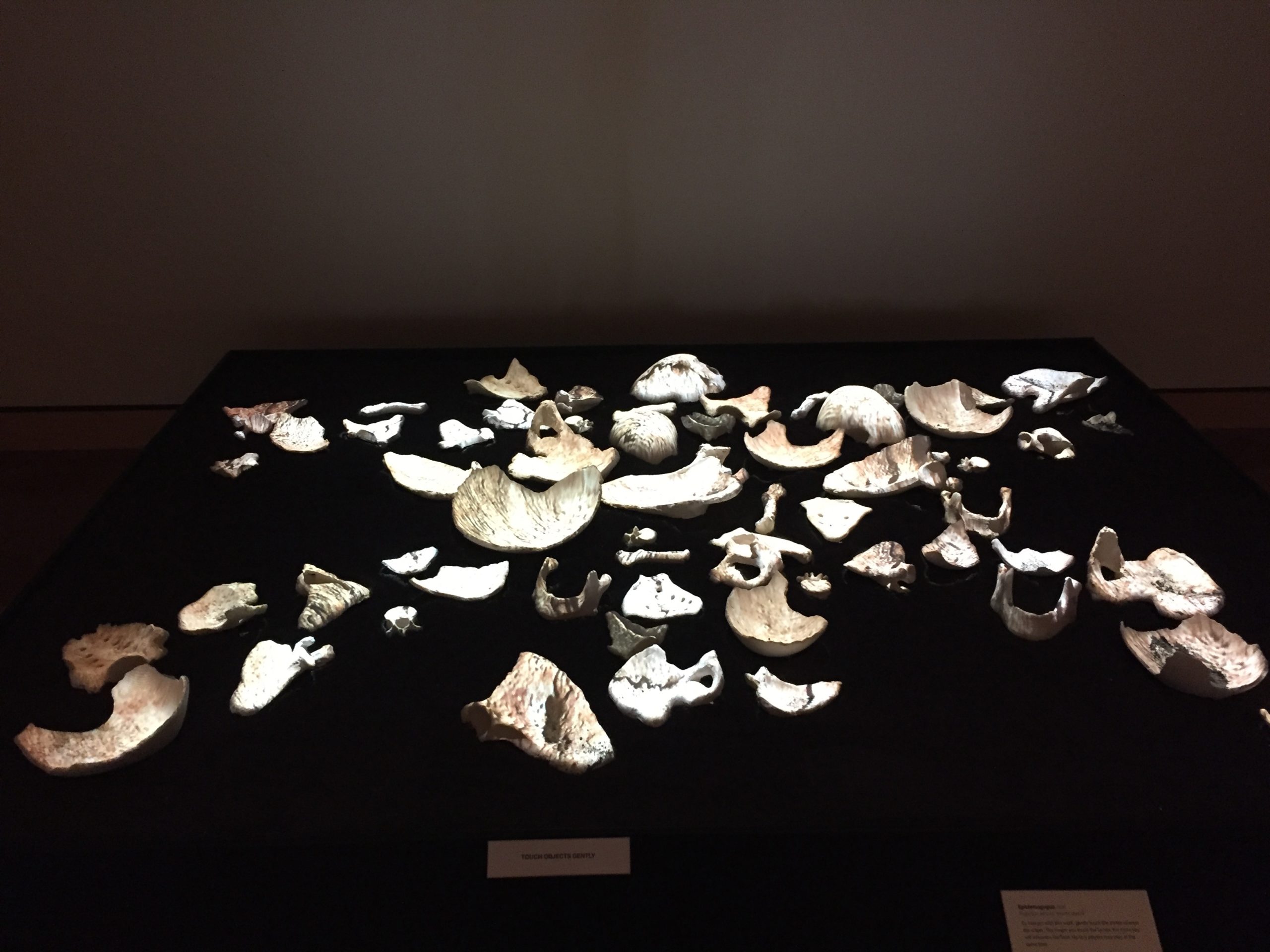Perchance to Dream
For all its media-rich elements, there's an air of the ancient, an uncanny, old-as-time tension between dreaming and waking life, that pervades the collaborative new installation by Dave Ryan and Mika Negishi Laidlaw, on view this spring at the Minneapolis Institute of Art.

For as much 21st century technology as is employed in the collaborative exhibition Uneasy Syzygies at the Minneapolis Institute of Art’s MAEP galleries, an aura of ancientness looms over the artwork. Perhaps it’s the use of ceramics, one of the world’s oldest art forms, or the pile of bones sitting in a bed of sand, that makes the show feel like a portal to some other past era. The nods to archaic superstitions and an exploration of one of the world’s great mysteries, dreams, also serve to situate the work in another epoch.
Dave Ryan, a media artist who works with interactive video; Mika Negishi Laidlaw, a ceramic artist; and Steve Ryan, a neuroscientist that specializes in sensor design, teamed up to create the exhibition, which consists of three installations. The show’s title refers to the concept of opposing forces that are in some way connected. It also alludes to the disparate backgrounds each of the three collaborators brings to the project. The term “syzygy” leaks thematically into the show’s content as well.
For example, two of the works included in the exhibition explore the relationship between waking and sleeping, and more specifically, dreaming. That symbiotic balance between our consciousness and unconsciousness fueled an entire body of psychoanalytic psychology, not to mention plenty of philosophical and religious writings before and after that. The line between waking and dreaming experience also persists as one of the great question marks of the universe. What the heck happens to us during the third of our lives that we enter that other realm of perception?
In Sleep Cycle, an assortment of ceramic pillows are arranged as if on a bed, with an adjacent bench for the visitor to sit and observe. The piece contains motion sensors, and any detected movement stops the video from playing. Only when observers sit in complete stillness do they experience the progression of images projected onto the “bed”: scenes of clouds, trees, and fire. Sleep Cycle forces the viewer into a kind of meditation, the kind of state that acts as a buffer zone between sleeping and waking life. One’s stillness is rewarded by a collage of images, mimicking the experience of dreaming. Fidgeting breaks the magic, turning the enlivened bed of pillows into stones once more.

On the opposite side of the gallery hangs the disturbing Vigilants installation, where a collection of “evil eyes” blink in alert anxiety. The eyes are projected onto ceramic shapes. Their gaze follows you, like Mona Lisa’s eyes, but without a beautiful painting surrounding and softening them. These eyes are stressed out and engulfing, no matter where you observe them from in the gallery. An allusion to the “evil eyes” found in many world cultures, where they can be both a curse and a ward against the same as talismans made for protection against harmful spirits, the evil eyes in this exhibit also suggest the dread of insomnia and wakefulness one feels when trying, and failing, to sleep.
This work forces the viewer into a kind of meditation, the kind of state that acts as a buffer zone between sleeping and waking life. One’s stillness is rewarded by a collage of images, mimicking the experience of dreaming. Fidgeting breaks the magic, turning the enlivened bed of pillows into stones once more.
Like Vigilants and Sleep Cycle, the third installation in the exhibit, Epidemagogue, makes use of video projection and sensors combined with ceramic objects. Instructions let the viewer know that the piece is a kind of game, where up to five players can participate at a time.
The piece is made up of an assemblage of ceramic objects made to look like fossilized bones. Touching the bones triggers the projections. The longer one touches the bones, the more it influences the field. Unfortunately, the instructions don’t lay out more specific rules for this particular game; if you happen to be visiting the gallery with friends who are good at that kind of thing, perhaps you can make up your own rules.In any case, the piece speaks to causal relationships, and how one tiny movement can have larger implications. The use of touch as a trigger connotes the way human contact spreads disease and infection.Epidemagogue also hints at the themes of dreaming and sleep present in the other two installations. Just as a slight movement of the bones sets into motion a whole sequence of related events, so too can a random thought or memory, a slight touch, a certain kind of food, influence our night’s dreaming.

Dreams are plastic things, unpredictable and explosive at times. Science still knows so little about them, or about how and why they happen in the ways they do. And yet, still, we have a certain, instinctive understanding of them. Perhaps our ancient selves, more than our analytical minds, are better equipped to interpret our dreams if we’d bother to listen.
Related exhibition information: Ryan / Laidlaw: Uneasy Syzygies is on view at the Minneapolis Institute of Art in the MAEP galleries from April 21 through July 3, 2016.